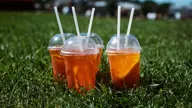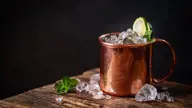Aluminium drinkware
3 minute read
Innovation and sustainability go hand in hand in today's era and are becoming increasingly synonymous with forward-thinking brands. So, what is happening in the growing challenge of plastic and how are drink brands alleviating this pressure point?
Let's have a look at the facts
Plastic waste is projected to triple by 2060, according to the latest forecasts by the OECD’s Global Plastics Outlook, rising from 353 million tonnes of waste in 2019 to 1,014 million tonnes in the next four decades. Two-thirds of this is expected to be made up of packaging, consumer products and textiles. Recycling rates are expected to improve in this time, rising from the 9% seen in 2019 to 17% in 2060.1
About 8% of the world’s oil production is used to make plastic and power the manufacturing of it and that figure is projected to rise to 20% by 2050. Less than a fifth of all plastic is recycled globally and 40% of plastic produced is packaging, used just once and then discarded.
Regulatory and legislative momentum is changing the landscape of plastic
In February and March of 2022, the UN Environmental Assembly met in Nairobi to discuss what could be the most influential environmental policy since the Paris accord. In an effort to address every aspect of plastic pollution, their goal is to utilize science-based policy when drafting this agreement. Through the creation of an Intergovernmental Negotiating Committee (INC), the UNEA hopes to have this agreement ready by 2024. This agreement will ideally recognize different approaches, emphasize the importance of this issue, and acknowledge the need for a legal framework.2
Policies and regulations focused on the disposal stage of the plastics value chain, such as China’s ban on imported waste, have significantly impacted global waste management systems and the secondary market. Shifting norms around plastic use are also being influenced by global civil society movements such as the BBC’s Blue Planet series and the Ellen MacArthur Foundation’s New Plastics Economy initiative.
Several countries, regions and cities have recently introduced regulations and legislations focused on plastic. These are primarily aimed at use and disposal to reduce consumption and improve waste management. Over 60 countries have implemented bans and levies on plastic packaging and single-use waste.3
Consumer’s perceptions of plastic
Plastic waste has risen up the agenda among governments, consumers and brands over the recent years. Consumers’ perceptions of single-use plastics have shifted as a result. Some 44% of consumers say they have recently become more concerned about single-use plastics, according to a study by Kantar Worldpanel, while 70% plan to change their behaviour in some way in response.4
Today’s beverage consumer is concerned with the overall sustainability of the products they are purchasing, especially related to plastic usage. Sixty-one percent of Millennials state they are happy to pay more for eco-friendly products, and by 2026 this group will command a 46% share of the beverage market. In general, 53% of consumers in the US and 65% of consumers in the UK support products that are environmentally friendly.5
What are the alternatives?
A premium yet durable solution for on-trade venues, festivals and events, is aluminium. Printing capabilities allow brands to decorate freely and include QR codes to launch digital experiences.
The cup is lightweight and stable, ideal for manoeuvring through crowded spaces. Using aluminium as a material gives the consumer a refreshing, colder drink to enjoy – adding further value to the consumer experience. Once the event is over, consumers may want to take the cup home as a collectible or as a reusable cup. With 360-degree printing capability, the cup truly is a billboard for brand messages. The printable area is ideal for logos, messaging and QR codes with up to 8 pantone colours.
Why aluminium?
- The global aluminium recycling rate is 70% - less than 20% of all plastic is recycled
- A can that is recycled today could be back on the shelf in 60 days
- 75% of all aluminium ever produced is still in use today
- It requires up to 95% less energy to recycle aluminium than to produce primary metal



